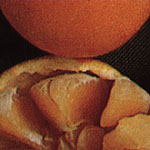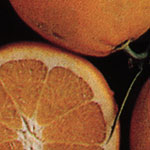

Robertson Navel Washington Navel


FoodFood InformationFruitCitrus Fruits
The United States is blessed with the world's finest oranges. They date
back to when Florida and California belonged to Spain and orange trees were
planted alongside numerous Spanish missions.
Since we grow oranges on both coasts, our fruit is available twelve months
of the year. Once in a while we import Jaffa, or Shamouti, oranges from
Israel; these are similar to our California Valencias. On rarer occasions
we import oranges from Spain and North Africa. Imported oranges are but
a drop in the bucket, with native supplies more than adequate to satisfy
our own demand and maintain us as a major exporter.
Due to differences in soil and climate, there are differences in the color,
texture, and juice content of California and Florida oranges. Even when
both areas grow an identical variety, the end product is not the same. Florida
oranges are thinner-skinned and have more juice than the ones grown in California,
but they are more difficult to peel and segment. As a rule, the Florida
orange is better for squeezing and the California orange is better for table
use. Much of the Florida crop is used to make frozen concentrate or sold
as fresh orange juice in paperboard containers and bottles. The California
oranges aren't quite as juicy and are not nearly as thin-skinned as the
Florida oranges. Both the skin and the flesh of the California oranges are
a deeper orange in color. All the California oranges and most of the Florida
oranges are seedless, but one important Florida variety, the Pineapple orange,
has lots of seeds.
Both California and Florida have two major crops of oranges each year. The
early crop from Florida has two varieties, the Hamlins and the Pineapple
oranges. The late Florida crop also has two varieties-the Valencias and
the Pope Summers. The early California crop is of the Valencia variety and
the late crop is known as the navel orange. Areas of Arizona that border
California produce some oranges, and Texas, a major producer of grapefruit,
grows a limited amount of oranges.
The first Florida orange to come to market arrives in October and is called
the Hamlin. This is our only variety that doesn't bat a thousand.
The Hamlins look like superb oranges-they are thin-skinned, seedless, and
heavy in weight, and they have good color. However, they are full of pulp.
They are pretty good when eaten as a table fruit, but they aren't very juicy
when squeezed. What juice they do yield is very pale and watery and lacks
flavor.
About four weeks after the arrival of the Hamlins, the Florida Pineapple
oranges come to market. They aren't quite as thin-skinned as the Hamlins,
but are just bursting with juice and flavor. This is one of our finest juice
oranges. If they have one fault, it is that they have seeds galore. This
variety is not grown in California.
During most of the month of November the look-alike Hamlins and Pineapples
are both in the market. The Hamlin is a loser and the Pineapple is a winner.
How can you tell them apart? You can't unless you cut into the orange. If
it is seedless, it's a Hamlin and won't be very juicy. If it has seeds,
it is a Pineapple and will have lots of juice.
The Pineapple oranges stay in season until mid-February. Late in January
the first shipments of the Florida Valencias arrive. While the Florida
Valencia is a superb juice orange, these first arrivals aren't quite
mature and therefore not as sweet as the Pineapple oranges already in the
market, nor are they as sweet as the Valencias will be later on in the season.
The trick is to buy the Pineapple oranges as long as they are available.
How can you tell these two look-alike varieties apart? Again, you have to
cut open the orange. If it has seeds, it's a Pineapple; if it is seedless,
it's a Valencia. However, even the earliest-arriving Valencia is a better
orange than the Hamlin. The Florida Valencia at full maturity is our finest
juice orange.
The Florida Valencias are joined in July by a later-blooming cousin called
the Pope Summer. These Florida oranges are available until mid-August.
In September and October the only orange in market for either juice or table
use is the California Valencia.
The California Valencias arrive late in May and are in the market
until December. The California navel oranges make their annual debut
in November and are in season until June. Note that the California seasons,
like the Florida seasons, overlap. The trick to getting the sweetest and
best textured California oranges is to buy the variety that has been in
the market for several months, not the one that is just coming into season.
For example, in May and June the California navels are superior to the newly
arriving Valencias. However, in November it is the Valencias that are sweeter
and juicier; the navels are not quite ready at that time.
The same pattern should be followed when purchasing Florida oranges: Always
purchase the ones that have been on the market for the longest period of
time.
Early in November and most of December, along with the California navel
oranges, there is a limited supply of Florida navels in market. Just as
the California grapefruit aren't nearly as good as those grown in Florida,
the Florida navels aren't nearly as good as the ones produced in California.
Florida navels have a light skin color and a light-colored flesh. They are
thin-skinned and difficult to peel and segment. The flavor and texture isn't
as good as that of a California navel.
Having covered the twelve-month cycle and the wisdom of purchasing the more
mature variety when two crops overlap, here are some tips on how to identify
top quality:
When shopping for oranges or any other citrus fruit, the hallmarks of quality
are the thinness of the skin and the weight of the fruit in relation to
its size. The color and the size are not clues to quality. The thinnest-skinned
fruit will be heavy in weight and have more juice. Since the smaller- and
medium-sized fruit are usually thinner-skinned and lower in cost, don't
purchase oversized fruit.




WHEN TO BUY: Available year-round
WHAT TO LOOK FOR: Firm, colorful, thin-shinned fruit that is heavy in relation
to size
HOW TO STORE: No refrigeration required if used within a week or two
Deamer 5/97